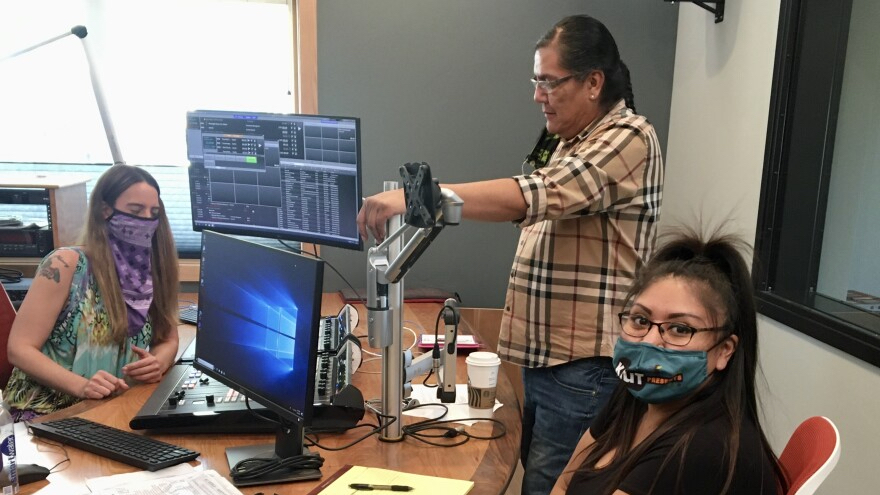Grants to Colorado radio stations will aid community engagement, elevate Indigenous voices

KSUT
Samantha Johnson, Mike Santisteven and Lorena Richards in KSUT's new facility.
Several public radio organizations in Colorado have received grants to strengthen and advance local news and better serve residents’ needs.
Awarded by the Colorado Media Project, the three-year grants are part of CMP’s efforts to support newsrooms, journalists and media entrepreneurs in the state, help launch initiatives and strengthen service to Coloradans.
CMP chose the outlets based on their missions of serving Colorado residents underserved by other outlets due to language, race, ethnicity or geography, according to a Jan. 26 press release.
KSJD in Cortez and KSUT in Ignacio will receive $135,000 to launch and support “Voices from the Edge of the Colorado Plateau.” The multiyear project will include a new full-time reporter position focusing on Indigenous affairs and will yield content for broadcast and online. The stations will also expand community engagement in their rural area of southwestern Colorado.
“For us in the Four Corners region, we’re definitely in a news desert, and we find ways to do our part to increase the availability of local and regional news,” Tami Graham, executive director of KSUT, told Current. “As part of that, we also know that with the large Native American population in our region … those voices are underheard across the region.”
KSUT was founded by the Southern Ute tribe in 1976. Though it is now independent of the tribe, Graham said it can still serve a role in elevating the voices of perspectives that traditionally have not been heard in the community, including Indigenous, Latinx and LGBTQ voices. The station hopes to create an advisory council of community members to share ideas for coverage and give feedback on the station’s reporting.
“This is really specific to our reporting on this topic — underserved, underheard voices, and we don’t want to presume that we know, internally, where the stories and the information is in our community,” she said. “We want to … have our community help inform the kind of stories they want to hear from these individuals.”
Rocky Mountain Community Radio is also among the public media organizations receiving a CMP grant. The coalition of stations in Colorado, New Mexico, Utah and Wyoming will receive $120,000 for a new reporter or managing editor position.
“For the better part of two decades, it has been our goal to increase the content we are able to share across our network, and one of the foundational aspects of that to make it work is connecting the dots between our newsrooms and assisting with content distribution in terms of story sharing and editing and making those stories digestible for our regional audience,” said Tyler Lucas, RMCR’s grant manager.
The network of 19 primarily rural and mountain community radio stations collectively reaches more than 415,000 listeners each week. The new position funded by the grant will expand thematic story collaboration, partnerships and distribution of work across the stations.
Donors are also contributing toward the position, which Lucas hopes will continue after the grant ends. Once the work of the person in the position gets off the ground, donors will see the value in supporting it, he said.
“We do anticipate that there will be increased interest in helping fund this type of really critical infrastructure in terms of the news environment in the region,” Lucas said.
Graham said she expects that KSUT and KSJD will be able to sustain the Indigenous affairs reporter position. She hopes to use momentum from the position to expand efforts to train younger and up-and-coming Native American journalists.
KSUT has received several grants in the past few years for elevating Native American voices, part of its strategic plan to expand local and regional programming. It also aims to create a Tribal Media Center in its new building it recently moved into as part of a capital campaign. The center would train young Native Americans interested in journalism and expand reporting in the region.
Having an Indigenous affairs reporter is important for telling stories in tribal communities that don’t just center on tragedy and hardship, Graham said.
“Often when Native Americans in our region are represented in the media, it’s because something really negative or bad has happened, and the media is always all over that,” she said. “Part of our vision is to elevate those stories of really amazing and wonderful things that are happening in our tribal communities from tribal members in our region.”





